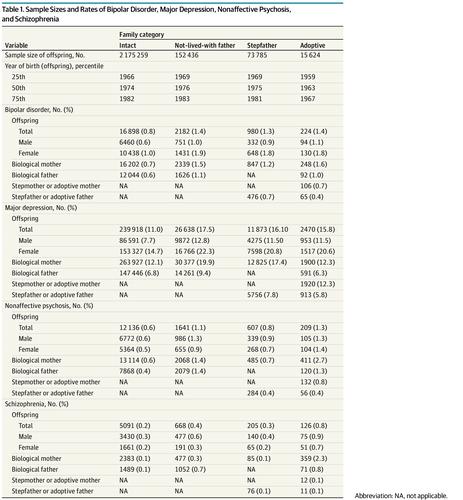JAMA Psychiatry ( IF 22.5 ) Pub Date : 2020-08-01 , DOI: 10.1001/jamapsychiatry.2020.0223 Kenneth S Kendler 1, 2 , Henrik Ohlsson 3 , Jan Sundquist 3, 4, 5 , Kristina Sundquist 3, 4, 5, 6

|
Importance Information about how risk for bipolar disorder is transmitted across generations and how parental risk for bipolar disorder relates to their children’s risk for schizophrenia and major depression is limited.
Objective To evaluate the sources of parent-offspring transmission of bipolar disorder and its familial cross-generational association with schizophrenia and major depression.
Design, Setting, and Participants Parents and offspring (born 1960-1990) from 4 family types were ascertained from Swedish national samples: intact (offspring, n = 2 175 259), not-lived-with biological father (n = 152 436), lived-with stepfather (n = 73 785), and adoptive (n = 15 624). Data analysis was conducted from October 28, 2019, to January 8, 2020.
Exposures Three sources of parent-offspring resemblance: genes plus rearing, genes only, and rearing only.
Main Outcomes and Measures Diagnosis of bipolar disorder, broad schizophrenia (ie, schizophrenia as a 3-level variable: unaffected, nonaffective psychosis, and schizophrenia) and major depression obtained from Swedish national registries. Parent-offspring resemblance was assessed primarily by tetrachoric correlation (ie, correlation of liability) and for key results, odds ratios (ORs) from logistic regression. Cross-generational associations of bipolar disorder with broad schizophrenia and major depression were assessed by their transmission from bipolar disorder in parents and transmission to bipolar disorder in offspring.
Results The study population included 2 417 104 individuals of 4 family types (51.8% male and 48.2% female; median age, 41 [range, 25-60] years). For bipolar disorder to bipolar disorder transmission, tetrachoric correlations for 3 types of parent-offspring relationships were statistically homogeneous across family type and mothers and fathers for genes plus rearing (0.25; 95% CI, 0.24-0.26), genes only (0.22; 95% CI, 0.18-0.26), and rearing only (0.07; 95% CI, −0.01 to 0.15). Parallel ORs were 5.20 (95% CI, 4.91-5.50), 3.66 (95% CI, 2.97-4.51), and 1.63 (95% CI, 0.96-2.78). Best-estimate, cross-disorder tetrachoric correlations for 3 types of parent-offspring relationships for bipolar disorder and broad schizophrenia were 0.12 (95% CI, 0.11-0.13) for genes plus rearing, 0.12 (95% CI, 0.09-0.14) for genes only, and −0.03 (95% CI, −0.11 to 0.04) for rearing only, with parallel ORs of 1.95 (95% CI, 1.93-1.97), 2.04 (95% CI, 1.75-2.38), and 0.76 (95% CI, 0.43-1.35). For bipolar disorder and major depression, the parallel tetrachoric correlations were 0.09 (95% CI, 0.07-0.10) for genes plus rearing, 0.04 (95% CI, 0.01-0.07) for genes only, and 0.05 (95% CI, 0.01-0.08) for rearing only; parallel ORs were 1.53 (95% CI, 1.50-1.57), 1.23 (95% CI, 1.13-1.34), and 1.25 (95% CI, 1.09-1.42). Heritability for bipolar disorder was estimated at 0.44 (95% CI, 0.36-0.48). Genetic correlations were estimated at 0.572 (95% CI, 0.560-0.589) between bipolar disorder and broad schizophrenia and 0.302 (95% CI, 0.001-0.523) between bipolar disorder and major depression.
Conclusions and Relevance The findings of this study suggest that genes are largely responsible for bipolar disorder transmission across generations, although modest rearing effects are also likely present. Cross-generational transmission between bipolar disorder and broad schizophrenia appears to be entirely genetic with a moderate genetic correlation; for bipolar disorder and major depression, transmission appears to result equally from genes and rearing with a modest genetic correlation.
中文翻译:

瑞典关于双相情感障碍疾病和精神分裂症与重度抑郁症的跨世代家族关联的瑞典国家收养研究。
重要性 有关双相情感障碍风险如何跨代传播以及父母双相情感障碍风险如何与子女患精神分裂症和严重抑郁症的风险相关的信息有限。
目的 评估双相情感障碍父母-子女传播的来源及其与精神分裂症和重度抑郁症的家族跨代关联。
设计,地点和参与者 从瑞典国家样本中确定了4种家庭类型的父母和后代(完整)(后代,n = 2 175 259),没有亲生父亲(n = 152 436) ,与继父同住(n = 73 785)和过继(n = 15 624)。数据分析于2019年10月28日至2020年1月8日进行。
暴露 亲子相似的三个来源:基因加饲养,仅基因和仅饲养。
主要结果和措施 对双相情感障碍,广泛性精神分裂症(即精神分裂症的3级变量:未受影响,非情感性精神病和精神分裂症)和从瑞典国家注册中心获得的严重抑郁症的诊断。父母与子女的相似性主要通过四方相关性(即责任相关性)进行评估,对于关键结果,通过逻辑回归得出比值比(OR)。躁郁症与广泛性精神分裂症和重度抑郁症的跨代关联通过其从父母的躁郁症的传播和后代的躁郁症的传播进行评估。
结果 研究人群包括4个家庭类型的2 417 104个人(男性为51.8%,女性为48.2%;中位年龄为41 [范围:25-60]岁)。对于双相情感障碍到双相情感障碍的传播,三种类型的亲子关系的四项相关在家庭类型以及父母和父亲的基因加抚育(0.25; 95%CI,0.24-0.26),仅基因(0.22; 95)上在统计上均一。 %CI,0.18-0.26),并且仅进行饲养(0.07; 95%CI,-0.01至0.15)。并行OR为5.20(95%CI,4.91-5.50),3.66(95%CI,2.97-4.51)和1.63(95%CI,0.96-2.78)。躁郁症和广泛型精神分裂症的三种亲子关系的最佳估计,交叉性四项式相关性,基因加抚育分别为0.12(95%CI,0.11-0.13),0.12(95%CI,0.09-0.14)基因和-0.03(95%CI,-0.11至0。04)仅用于饲养,平行OR为1.95(95%CI,1.75-2.38),2.04(95%CI,1.75-2.38)和0.76(95%CI,0.43-1.35)。对于双相情感障碍和重度抑郁症,基因加饲养的平行四项相关为0.09(95%CI,0.07-0.10),仅基因为0.04(95%CI,0.01-0.07),以及0.05(95%CI,0.01-0.01)。 0.08)仅用于饲养;平行OR为1.53(95%CI,1.50-1.57),1.23(95%CI,1.13-1.34)和1.25(95%CI,1.09-1.42)。双相情感障碍的遗传力估计为0.44(95%CI,0.36-0.48)。躁郁症和广泛性精神分裂症之间的遗传相关性估计为0.572(95%CI,0.560-0.589),躁郁症和严重抑郁症之间的遗传相关性为0.302(95%CI,0.001-0.523)。对于双相情感障碍和重度抑郁症,基因加饲养的平行四项相关为0.09(95%CI,0.07-0.10),仅基因为0.04(95%CI,0.01-0.07),以及0.05(95%CI,0.01-0.01)。 0.08)仅用于饲养;平行OR为1.53(95%CI,1.50-1.57),1.23(95%CI,1.13-1.34)和1.25(95%CI,1.09-1.42)。双相情感障碍的遗传力估计为0.44(95%CI,0.36-0.48)。躁郁症和广泛性精神分裂症之间的遗传相关性估计为0.572(95%CI,0.560-0.589),躁郁症和严重抑郁症之间的遗传相关性为0.302(95%CI,0.001-0.523)。对于双相情感障碍和重度抑郁症,基因加饲养的平行四项相关为0.09(95%CI,0.07-0.10),仅基因为0.04(95%CI,0.01-0.07),以及0.05(95%CI,0.01-0.01)。 0.08)仅用于饲养;平行OR为1.53(95%CI,1.50-1.57),1.23(95%CI,1.13-1.34)和1.25(95%CI,1.09-1.42)。双相情感障碍的遗传力估计为0.44(95%CI,0.36-0.48)。躁郁症和广泛性精神分裂症之间的遗传相关性估计为0.572(95%CI,0.560-0.589),躁郁症和严重抑郁症之间的遗传相关性为0.302(95%CI,0.001-0.523)。和1.25(95%CI,1.09-1.42)。双相情感障碍的遗传力估计为0.44(95%CI,0.36-0.48)。躁郁症和广泛性精神分裂症之间的遗传相关性估计为0.572(95%CI,0.560-0.589),躁郁症和严重抑郁症之间的遗传相关性为0.302(95%CI,0.001-0.523)。和1.25(95%CI,1.09-1.42)。双相情感障碍的遗传力估计为0.44(95%CI,0.36-0.48)。躁郁症和广泛性精神分裂症之间的遗传相关性估计为0.572(95%CI,0.560-0.589),躁郁症和严重抑郁症之间的遗传相关性为0.302(95%CI,0.001-0.523)。
结论与相关性 这项研究的发现表明,基因可能是导致两代人双相情感障碍传播的主要因素,尽管也可能存在适度的抚育作用。双相情感障碍和广泛性精神分裂症之间的跨世代传播似乎是完全遗传的,具有中等遗传相关性。对于双相情感障碍和重度抑郁症,传播似乎同样是由基因引起的,并且具有适度的遗传相关性。











































 京公网安备 11010802027423号
京公网安备 11010802027423号